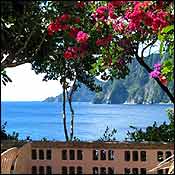
#21 (of 25) NEXT >>
Five hundred years after Carib Indians chased Columbus’s men away with poisoned arrows, the island of Dominica is probably the only place on earth that the discoverer of the Americas would still recognize. Its mountainous rain forests are largely untouched, and St. Barts–style tourism has mercifully spurned the island for glitzy neighbors like Martinique and Guadeloupe, whose residents think of Dominica as a deprived backwater—no flashy discos, no casinos, certainly no $600 hotels.
For corporate resort-builders, Dominica’s lack of white-sand beaches may be a curse, but for anyone who likes to hike, dive, and soak up authentic Creole culture, it’s a blessing. On Dominica (not to be confused with the much larger Dominican Republic), you can drink from streams without a second thought and dive off reefs that have never felt the smack of an anchor. You can explore networks of old slave and Indian trails that cut across the island’s furled ridges and valleys. If you happen to cross paths with a farmer carrying a bag of fruit to market, you’ll be greeted with a broad smile and a handshake as warm as an embrace.
Dominica’s national motto, “Après Bon Dieu, c’est la Terre,” translates to “After God, the Earth.” The vast majority of Dominicans grow their own food, and the island has inherited the biodiversity of former occupying empires (the country has a British and French legacy). Bananas, breadfruit, pineapples—nearly everything that has been planted in the fertile soil here has flourished.
After I’d spent a few days hiking, swimming, and scuba diving near Soufrière, a local named Aaron got me hooked on waterfall hunting. Dominica has some 365 rivers—the cliché is that there’s one for every day of the year—and of the thousands of cascades on the island, only a dozen or so are on the map. Many of the highest and most dramatic lie deep in Dominica’s little-explored interior, accessible only via challenging hikes.
Perhaps my favorite was a falls not far from the east-coast village of Petite Soufrière. To get there, Aaron and I humped up a steep trail past chatagnier and baobab trees, weaving through the towering buttressed gommiers from which the Caribs carved their ocean-going canoes. (Along the way, Aaron pointed out the local aphrodisiac, bwa bande—literally, “big wood”—which, whatever its sexual properties, makes a powerful elixir, I can attest, when mixed with home-brewed rum.) Reaching the river, we scrambled over volcanic boulders and ducked under downed trees until we came to a clearing. There, the object of our quest tumbled from above, off the lip of an 80-foot cliff. Purple orchids and yellow-clawed heliconias flared against a backdrop of mosses and vines. I stood for a minute to enjoy the natural air-conditioning, then let out a whoop and jumped into the deep pool.
I spent the next week churning through the jungle, getting dirty and sweaty and thirsty and then washing off under torrential spigots. Toward the end of my stay, in a village called Wotten Waven, I made friends with a group of locals who invited me over for callaloo soup. Over the late-night barking of crapaud frogs, a man nicknamed Mellow leaned over and told me about a secret waterfall in the hills above the village, where he goes when he wants to be alone.
“That’s the best place I know,” he told me, “to check your vibe.”
DETAILS
Dominica doesn’t have gated resorts, but it does have several good family-owned inns, including the Zandoli Inn (767-446-3161 or zandoli.com; from $140), whose rooms and pool are nestled on a promontory overlooking Grand Bay. For more information, contact the Dominica Tourist Office (212-949-1711 or dominica.dm).